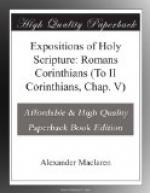To Paul there was the closest and most vital connection between the profoundest experiences of the Christian life and its plainest and most superficial duties. Here he lays one of his most mystical conceptions as the very foundation on which to rear the great structure of Christian conduct, and links on to one of his profoundest thoughts, the unity of all Christians in Christ, a comprehensive series of practical exhortations. We are accustomed to hear from many lips: ’I have no use for these dogmas that Paul delights in. Give me his practical teaching. You may keep the Epistle to the Romans, I hold by the thirteenth of First Corinthians.’ But such an unnatural severance between the doctrine and the ethics of the Epistle cannot be effected without the destruction of both. The very principle of this Epistle to the Romans is that the difference between the law and the Gospel is, that the one preaches conduct without a basis for it, and that the other says, First believe in Christ, and in the strength of that belief, do the right and be like Him. Here, then, in the very laying of the foundation for conduct in these verses we have in concrete example the secret of the Christian way of making good men.
I. The first point to notice here is, the unity of the derived life. Many are one, because they are each in Christ, and the individual relationship and derivation of life from Him makes them one whilst continuing to be many. That great metaphor, and nowadays much forgotten and neglected truth, is to Paul’s mind the fact which ought to mould the whole life and conduct of individual Christians and to be manifested therein. There are three most significant and instructive symbols by which the unity of believers in Christ Jesus is set forth in the New Testament. Our Lord Himself gives us the one of the vine and its branches, and that symbol suggests the silent, effortless process by which the life-giving sap rises and finds its way from the deep root to the furthest tendril and the far-extended growth. The same symbol loses indeed in one respect its value if we transfer it to growths more congenial to our northern climate, and instead of the vine with its rich clusters, think of some great elm, deeply rooted, and with its firm bole and massive branches, through all of which the mystery of a common life penetrates and makes every leaf in the cloud of foliage through which we look up participant of itself. But, profound and beautiful as our Lord’s metaphor is, the vegetative uniformity of parts and the absence of individual characteristics make it, if taken alone, insufficient. In the tree one leaf is like another; it ’grows green and broad and takes no care.’ Hence, to express the whole truth of the union between Christ and us we must bring in other figures. Thus we find the Apostle adducing the marriage tie, the highest earthly example of union, founded on choice and affection. But even that sacred bond leaves a gap between those who are knit together by it; and




